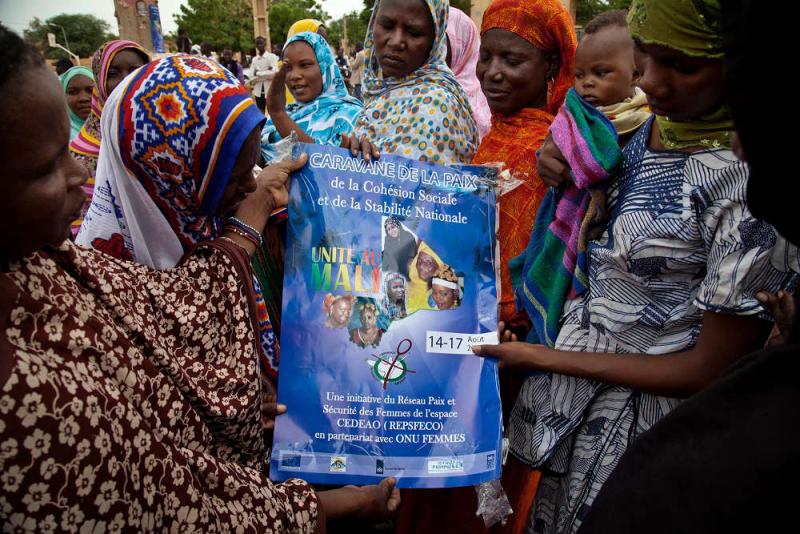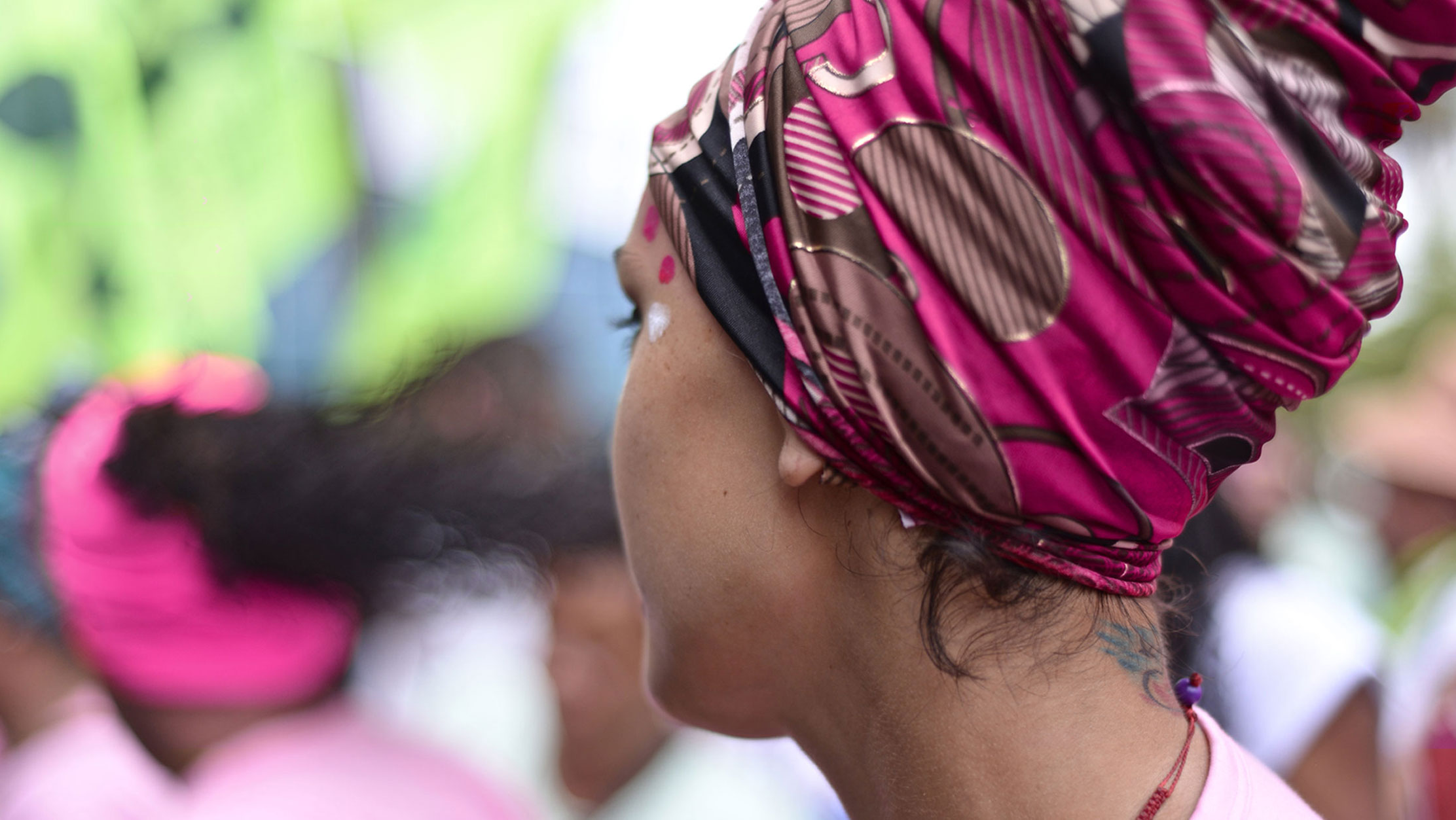Following the signing of the Agreement for Peace and Reconciliation in Mali on 20 June 2015 (also known as the Algiers Agreement), AWID spoke with Bintou Founé Samaké Bouaré, president of WILDAF/Mali[1], and Fatoumata Maiga, founder and president of the Association des Femmes pour les Initiatives de Paix, AFIP (Association of Women for Peace Initiatives) to learn more about mainstreaming gender into the Mali peace building process and the associated challenges.

Multifaceted nature of the conflict
Since 2012, Mali has faced serious security and political crises marked by, among others, the March 2012 military coup, attacks by armed groups and militias in the North and Jihadist occupation of the North and its progression toward the South; the French military Operation Serval between January 2013 and July 2014; and finally the establishment of a peace negotiation process between different stakeholders of the conflict, under the mediation of Algeria, which resulted in the signing of a peace agreement last month.
These different phases of the Malian crisis are generally analysed with a security lens; yet, “the root cause of the Malian crisis is bad governance,” says Bintou Founé Samaké Bouaré. She adds that this crisis has had serious implications for different populations, especially women and girls, who, among other, have been victims of rape, abduction, wrongful incarceration, flogging, stoning, forced marriage, and have lost material and financial resources. As such, six organizations[2] filed a complaint in November 2014 to the Bamako Commune III Court of First Instance, in the name of 80 victims of rape and sexual violence committed by armed groups during the occupation of the North in 2012 and 2013. Fatoumata Maiga notes that one of the serious consequences of the conflict for women has included “the destruction of social infrastructures like schools, health centers, production centers and women’s cooperatives.”
In an open letter addressed to United Nations Secretary General Ban Ki Moon in December 2014, activist Aminata Dramane Traoré says that the violence against African women is also rooted in the liberal international order, in particular the extensive implementation of structural adjustment programmes in this region in the 1980s and 1990s. The crisis in Mali thus manifested in a society “affected by three decades of economic restrictions that have caused nothing but unemployment, mass poverty, inequalities, corruption and impunity.”
Women’s movements mobilising for peace
“To end this crisis, women decided to get seriously involved in its resolution. As a result, women developed different peace building initiatives in the country. To have their voices heard, they formed a common front by establishing an informal structure they named the ‘Women’s Alliance for a United Mali’,” explains Samaké Bouaré.
Resistance, mobilization and denunciations have taken place, mainly through marches in the capital Bamako, and in the Kidal, Gao and Timbuktu regions[3], those occupied by armed groups, and SMS messages were used to form engagement groups with young people in the Gao and Kidal regions. Support systems have also been initiated, especially for women threatened with execution by religious fundamentalist groups.
In terms of peacemaking, the AFIP has committed to supporting women from Ménaka[4] to facilitate cohesion between them, despite differing perspectives on national unity and separation of the North. In order to eradicate weapons and return confidence between communities, training was held in the Gao region on possession of weapons by communities.
Samaké Bouaré recalls that the Malian women’s manifesto on participatory crisis management and exit strategy, which analyzed the situation through a gender lens, was produced in 2012, addressing the humanitarian response, violence, the period of transition and elections, including an exit strategy to the crisis. That same year, forty-something Malian women leaders communicated their demands and recommendations to Jan Eliasson, Deputy Secretary-General of the United Nations and to Michelle Bachelet, then Executive Director of UN Women. Samaké Bouaré says, “These recommendations were favourably received by Mali’s technical and financial partners and initiatives for the inclusion of gender were planned thereafter. The funds flowed through the State, but shortly following the 2013 presidential and legislative elections, we were witness to major misappropriation of World Bank and IMF funds, and women never benefited from the funds allocated to Mali”. Maiga also underscores the “difficulty of mobilizing resources for women’s organizations since the rise of the political and security crisis, even though they are the ones on the ground.”
A peace agreement that ignores gender implications and lacks sustainable solutions
The Mali Women Leaders’ Platform has worked since the onset of negotiations to include Malian women’s priorities in the peace agreement, all while articulating the contents of the agreement to hundreds of Malian women. All of the initiatives toward a gender-sensitive peace building process, include advocacy from women’s movements at the national, regional and international level to “take into consideration the needs of women in the Algiers Agreement, recognizing women as victims,[5] facilitating their access to justice, creating a compensation fund for victims, operationalizing the Truth, Justice and Reconciliation Commission,[6] and passing a quota for women’s access to decision-making posts,” says Samaké Bouaré. Maiga adds that for women, justice and reparation need to be carried out equally effectively at the economic, social level and cultural levels and that establishing sustainable peace in Mali requires the presence of women in all related mechanisms.
Despite these strategies and the energy of feminist movements for peace in Mali, Samaké Bouaré notes that, “the peace negotiation process is not gender-sensitive. Women have barely been present through the course of negotiations, which is in contravention to Resolution 1325 of the UN Security Council. The resolution, adopted in 2000, underscores the importance of equal participation of women and men in peace building and peacekeeping. Successively since 2000, six additional resolutions have been adopted by the UN Security Council to complete the framework for implementing and monitoring the Women, Peace and Security agenda.
Devoid of gender issues, the content of the agreement signed by all conflict stakeholders on 20 June, following almost a year of negotiations, also only focuses on restoring order and security in the North, at a time when the population needs the State to provide social, judicial and educational services. The agreement thus constitutes a missed opportunity for establishing sustainable solutions and “repeats mistakes of the past, encouraging, for example, models of decentralisation and clientelism[7]that have failed to bring peace. Rather than trying to change a deeply flawed political system, it seeks only to strengthen the institutions within it. The Malian parties, who refused to engage in direct dialogue, inherit a document that is written mostly by international mediators and in part reflects the mediators’ own interests. It prioritises the restoration of order and stability rather than aiming to meet a desire for genuine change that runs deep among northern populations,” as reported by the International Crisis Group in May 2015.
On 28 June 2015, the UN Security Council adopted Resolution 2227, which renews the mandate of the United Nations Multidimensional Integrated Stabilization Mission in Mali (MINUSMA) until 30 June 2016, to refocus on implementation of the peace agreement and monitoring the cease-fire, with the deployment of 40 military observers to this end. While the Resolution mentions certain points linked to gender-based violence, especially sexual violence, women’s movements continue to mobilize to have their voice heard in Mali’s priorities. Maiga concludes “It is important to consider the priorities of women and young people in reintegration, as planned by the peace agreements in the Disarmament, Demobilization and Reintegration Framework, but also of the women who accompanied combatants and those who led resistance movements alongside young people during the occupation, all the while supporting community agents of peace. In general, women are figuring out how to elaborate their priorities according to different parts of the agreement, to develop a Malian national action plan on Resolution 1325 and other UN Security Council Resolutions on women, peace and security.”
